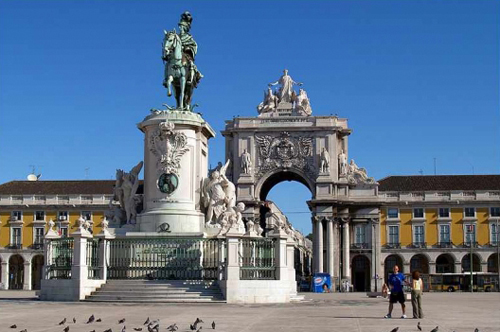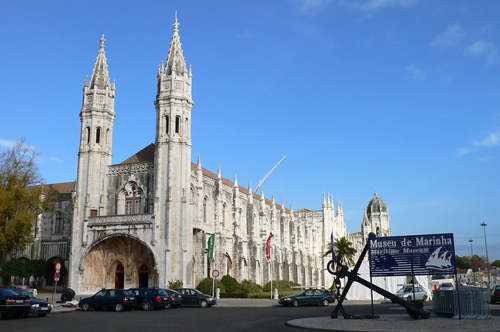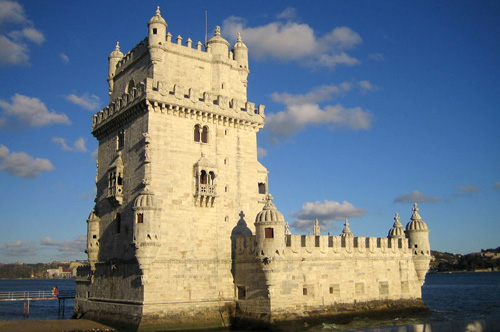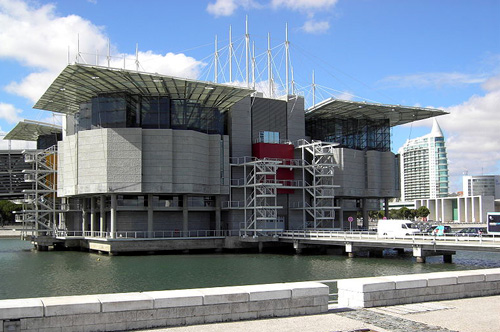|
The Praça do Comércio or Commerce Square is located in the city of Lisbon, Portugal. Situated near the Tagus river, the square is still commonly known as Terreiro do Paço or Palace Square because it was the location of the Paços da Ribeira (Royal Ribeira Palace) until it was destroyed by the great 1755 Lisbon Earthquake. After the earthquake, the square was completely remodeled as part of the rebuilding of the Pombaline Downtown, ordered by the Marquis of Pombal.
The Hieronymites Monastery (Mosteiro dos Jerónimos) is a magnificent monastery that is considered one of the most prominent monuments in Lisbon and is certainly one of the most successful achievements of the Manueline style (Portuguese late-Gothic). The house for the Hieronymite monks was built on the same site of the Ermida do Restelo, a hermitage that was founded by Henry the Navigator at about 1450. It was at this hermitage, that was already in disrepair, that Vasco da Gama and his men spent the night in prayer before departing for India in 1497. Kneeling statue of King Manuel I – main sponsor of the Monastery – on the Western portal. The figure behind the king is Saint Jerome. The existing structure was started on the orders of Manuel I (1515–1521) to commemorate Vasco da Gama's successful return from India. Within the church, close to the western portal, are the stone tombs of Vasco da Gama (1468–1523), and of the great poet and recorder of the discoveries, Luís de Camões (1527–1570).
The Maritime Museum (Portuguese: Museu de Marinha) of Lisbon is dedicated to all aspects of the History of navigation in Portugal. The museum occupies a part of the neo-Manueline Western wing of the Jerónimos Monastery (together with the National Museum of Archaeology) as well as a modern annex built to the North of the monastery. The history of the museum is deeply related to King Luís I (1838-1889), who was a lover of oceanographic studies and an accomplished navigator himself. He created in 1863 a collection of items related to the preservation of maritime history of Portugal, a collection that was enlarged in the following decades, culminating in the inauguration of the Maritime Museum in 1963 in its present location.
Belém Tower (in Portuguese Torre de Belém), is a fortified tower located in the Belém district of Lisbon, Portugal. It is an UNESCO World Heritage Site (along with the nearby Jerónimos Monastery) because of the significant role it played in the Portuguese maritime discoveries of the era of the Age of Discoveries. The tower was commissioned by King John II to be both part of a defense system at the mouth of the Tagus River and a ceremonial gateway to Lisbon. The tower was built in the early 16th century and is a prominent example of the Portuguese Manueline style, but it also incorporates hints of other architectural styles. The structure was built from lioz limestone and is composed of a bastion and the 30 meter (100 foot), four story tower.
The Oceanarium in Lisbon, Oceanário de Lisboa, is an oceanarium dedicated to the ocean. It is located in the Parque das Nações, which was the exhibition grounds for the Expo '98. The Lisbon Oceanarium’s conceptual design, architecture, and exhibit design was led by Peter Chermayeff. It is said to resemble an Aircraft carrier, and is built into the pier on an internal sea. Read more about Lisbon at wikipedia.com |




